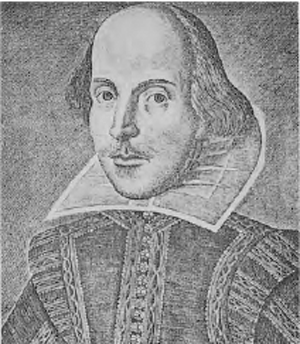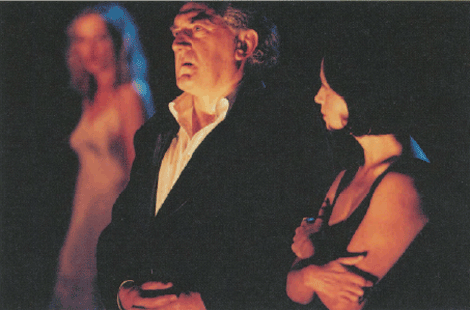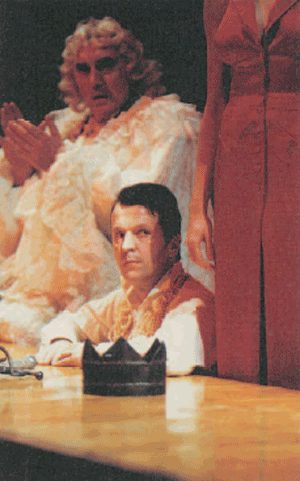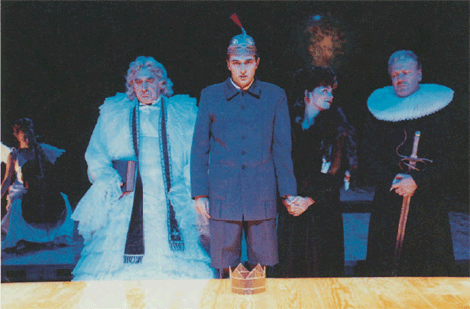The Low Countries. Jaargang 7
(1999-2000)– [tijdschrift] The Low Countries–
[pagina 203]
| |||||||||||
Recycling Shakespeare in the Low Countries‘For each man kills the thing he loves,  A familiar picture: the portrait of Mr William Shakespeare on the frontispiece of the First Folio (London, 1623) was made by Martin Droeshout, an engraver of Dutch descent.
In recent years, theatre audiences in the Low Countries have been treated to a series of remarkable Shakespeare productions. These include Toneelgroep Amsterdam's Richard III with Pierre Bokma as the seductive gangster-king, Johan Doesburg's Troilus and Cressida and Titus Andronicus for Het Nationale Toneel, Franz Marijnen's rendering of The Tempest at the Koninklijke Vlaamse Schouwburg, Romeo and Juliet at the Zuidelijk Toneel, and De Trust's Friedrichswald (As You Like It) as well as its awardwinning Hamlet of 1997-1998, with Jacob Derwig in the lead. The 1990s have yielded an opulent dramatic harvest indeed, but few will wish to challenge the claim that the chief event in the recent theatre history of the Low Countries has been the production of Tom Lanoye and Luk Perceval's To War (Ten oorlog).Ga naar eind1. To War is a startling production of Shakespeare's eight major history plays, conveniently rewritten for the purpose and rolled into a three-part cycle about the successive reigns of Richard ii, Henry iv, Henry v, Henry vi, Edward iv, and Richard iii. This epoch-making project, realised by Blauwe Maandag Compagnie in collaboration with theatres in Ghent, Antwerp and Rotterdam, has created a stir for a number of reasons. These include its vast scope and the sheer physical demands that the production makes on actors and audiences alike, but also its manifest irreverence vis-à-vis the venerable Mr William Shakespeare. The new text is approximately half the length of the assembled Shakespeare plays. Furthermore, the plays have been substantially rewritten, with new material added, not only in Dutch and ‘Flemish’ colloquial language, but also in French, Italian, British English, and American English. It would be an understatement to say that this 1990s rendering of Shakespeare's Elizabethan original fails to conform to any traditional trans- | |||||||||||
[pagina 204]
| |||||||||||
 Ariane van Vliet in To War (Ten oorlog). Photo by Corneel Maria Ryckeboer.
lation standards. Even as an adaptation the result must be labelled extravagant. All this suggests that the main reasons for the project's popularity must be sought elsewhere. A closer look at some of the salient strategies adopted by Lanoye and Perceval suggests that the production appeals to a series of interrelated concerns that range from the political rule and misrule of the Belgian nation to the contemporary plight of the literary artist vis-à-vis his cultural heritage and the condition of his principal medium, language. However unique To War's interaction with the current politico-social climate in the Low Countries may be, the question remains if such Shakespeare practice itself, too, is unprecedented. | |||||||||||
‘Ma chère enfant’To War departs from the original Shakespeare material in a number of important ways. If we start at the beginning, one of the more notable changes is the representation of Richard the Second's queen in the early scenes of the first part of the trilogy, entitled In the Name of the Father and the Son. Unlike Shakespeare, who first presents the queen in the famous garden scene where she expresses her apprehensions about the fate of her husband (2.2), Lanoye and Perceval introduce her as ‘La Reine’ in the very opening scene of the play. The Flemish adapters foreground her even further by turning Shakespeare's young but mature wife to the homosexually inclined Richard into an infant bride. Lanoye and Perceval rewrite Shakespeare where, for practical reasons, Shakespeare departed from his historical source material to profit from an additional, mature female speaker in the play. The Flemish reason for subverting Shakespeare's presentation of history here from the outset is not rooted in any desire for historical accuracy; | |||||||||||
[pagina 205]
| |||||||||||
on occasion, their own departure from Shakespeare's history is even more drastic. There is little doubt that this manipulation of the queen in the text of Richard II serves to align the play more accurately with the disturbing Belgian present, following the traumatic discovery of a number of cases of child abuse (among which the so-called ‘Dutroux case’), and increasing certainty about the corruption of state justice. Such a reading of the editorial intervention is inevitable, given the first exchange of words between Richard and his child-queen, shortly before the king corrupts the judicial system for his convenience by hindering divine justice at Coventry. The dialogue rehearses childlike innocence, affection, physicality, and age difference, but also a mode of senior male domination symbolised in the forms of address, and supported by the combination of the queen's use of the interrogative and the monarch's of the imperative manner:
La Reine:
(whispering affectionately in Richard's ear) Richaar
Je vous en prie, laissez-moi faire pipi.
Richaar:
(whispers back) Ma chère enfant,
N'attends que pour un tout petit instant.
(kisses her forehead).
Matters are equally unambiguous in the second act where we find the French queen playing with a doll, as Richard, surrounded with his flatterers, is treated to poetry with allusions of an increasingly eschatological nature. Here, on the eve of his departure for Ireland, Richard is also eager to sleep with his child-queen, and the proper stress on the French word ‘reine’ in this multilingual translation-cum-adaptation poignantly activates the Dutch meaning of ‘reine’ as ‘pure’ (1:37). All this does not prepare one for the shock when in the next scene the sexually initiated queen has her first period, while still childlike humming a French nursery rhyme (2.3), before speaking her version of Shakespeare's lines about ‘Some unborn sorrow, ripe in fortune's womb’ (2.2.10), expressing her premonition of Richard's fall and the onset of civil war and national chaos. The allusions to child abuse in the first part of the trilogy are also easily reactivated during the famous sequence of the princes' murder in the Tower in the third part, And Deliver Us from Evil. However, one cannot accuse Lanoye and Perceval of glibly cashing in on a facile analogy. In fact, they make sure to invest the sequence with more than just an expedient expression of disapproval. On the one hand, they introduce a note of wry humour, for example when Richard iii tempts the two youngsters to take up residence in the dreaded Tower. As he puts it in that curious amalgamation of Dutch and English so typical of the third part of To War: ‘Toe (=Come) little Richard, / Won't you go to the Toren (=Tower), too?’ (3:83). On the other hand, the adapters heighten the sense of horror when they have Richard devour the princes' corpses on stage. To Richard, as Lanoye sees it, the two nephews are his greatest source of humiliation, the most painful reminder of his wickedness, of his hideous exterior, of his unloved state, and hence they are also the true agents of his disintegration, a process whose lowest point is reached when Richard eats them in full view of the audience, in an image worthy of Francis Bacon. | |||||||||||
[pagina 206]
| |||||||||||
Killing the thing one lovesAnother telling change effected by Lanoye and Perceval occurs at the end of the Henry IV sequence, where Prince Hal kills his father, Henry the Fourth. In Shakespeare's Henry IV, the eponymous king fears that his prodigal son will steal the crown by his deathbed. The king proves to be mistaken, however, and a degree of understanding and reconciliation is reached between him and his son in the end. In Lanoye and Perceval, Bolingbroke and Hal meet not at the former's deathbed, but on the battlefield where Hal, in an apparently gratuitous display of violence, chokes the already dying king. Initially, this departure from Holinshed and Shakespeare raises only questions, until this gesture proves to correspond rather accurately with Lanoye and Perceval's view of Bolingbroke and (ultimately also) his son, as dictatorial politicians, as right-wing Flemish nationalists, two leaders with Realpolitik as their ideal, men with ideas about human evolution, society, gender, and leadership that echo some of the more disturbing elements in current Belgian, or rather Flemish, politics. Under the circumstances, the one-time prodigal son's assassination of his frail and ailing progenitor is the best fate that the latter could meet with; the son ratifies his father's policies precisely by negating him at this stage. This is the politics of In the Name of the Father and the Son, but also of the later plays. If in Shakespeare, Henry the Fourth gives his son the memorable advice to distract rebellious native nobles by waging war abroad against a single enemy that demands a unified stance - ‘be it thy charge to busy giddy minds with foreign quarrels’ - Lanoye and Perceval's monarchs eliminate the needy, the weak, or those who are sexually ambiguous like the gender-riddled Falstaff in the play. In The Fortunes of Falstaff (1943), John Dover Wilson gave a famous account of Falstaff as the surrogate father to Hal, but since the publication of Valerie Traub's magnificent Desire and Anxiety: Circulations of Sexuality in Shakespeare (1992), Falstaff is also the surrogate mother to the prince, which explains how, on the one hand, as a transvestite, he/she breastfeeds Hal in the new Flemish adaptation, and, on the other, has no place in the kingdom which the prince comes to rule, a kingdom founded on extreme notions of purity and male fantasies realised by designating as effeminate and precarious everything that might threaten to undermine the hegemony. In the role that Falstaff plays as the begetter of wit with his feminine ‘belly full of tongues’, he has more in common with the prostitutes whom he frequents than with the anxieties of such meritocratic males as Prince Hal. It is heavily symbolic therefore that in Lanoye and Perceval, an upstaged Falstaff dies as Henry and Katherine are engaged in an act of banal copulation. Given the overall nature of the To War adaptation, however, it seems less important to note the adapters' drive for a degree of consistency in their adaptation, than to recognise in Prince Hal's unanticipated instance of patricide the clearest sign of Lanoye and Perceval's oedipal affiliation with Shakespeare, a means of mastering their so-called anxiety of influence. It is an avowed love-hate relationship, brought into focus by the quotations which adorn the various parts of To War. There are passages from Goethe arguing that Shakespeare presents a serious threat to budding talent, since he invites imitation and keeps the young poet from fashioning himself; and from Camilla Paglia preaching an iconoclastic approach to the classics, as a means of redeeming them. Just as Prince Hal symbolically blocks his father's mouth in an attempt to kill the old man and to perpetuate the fami- | |||||||||||
[pagina 207]
| |||||||||||
ly's rule over England, so Lanoye and Perceval, in a contemporary history play of their own making, drown out Shakespeare's voice with the aim briefly to rule in the cherished realm of literature. Prince Hal's annihilation of his father is an obvious analogy to Lanoye and Perceval's undertaking. Just as in this scene Prince Hal achieves the crown of England by means of a combined act of patricide and regicide, so Lanoye and Perceval attain their own crown of laurels by iconoclastically leaving the sacrosanct Shakespeare text behind, and rewriting history as well as Shakespeare in their own image. Returning to the trilogy, one notes that this love-hate relationship, with killing as an expression of love, pervades the Flemish version of the Shakespeare plays from beginning to end, both on the level of history, and on the level of literature. There is a straight line from Hal's killing of Henry iv in the first part of the trilogy, to the dying complaint of the hunchbacked Richard iii to his mother: ‘The cowardice of your love let me live, / Where true love would have strangled me’ (3: 112). The philosophy of history unmistakably intersects with the literary aesthetics of Lanoye and Perceval when Richard the Third, after killing his brother George of Clarence earlier in the play, is made to address the audience with the words: ‘One thing I'll teach the world, willens nillens; / There is tremendous poetry in killings’ (3: 74). The original idea for To War was developed during work on Richard III, and it seems likely that these lines capture the original fascination with Shakespeare's history and Shakespeare's language that paradoxically also justifies fully the passionate act of demolition that is entitled To War. | |||||||||||
No admiration, but emulationThe immense press coverage and the wide popular acclaim that To War has enjoyed, might suggest that we are witnessing an unprecedented phenomenon. This is not altogether true. The project is unique in a number of ways, not least because of the various ways in which, by appropriating the two Shakespeare tetralogies, Lanoye and Perceval manage to write the contemporary history of Belgium. It is stunning to witness the ease with which Jan Decleir and Els Dottermans in To War (Ten oorlog). Photo by Corneel Maria Ryckeboer.
| |||||||||||
[pagina 208]
| |||||||||||
Shakespeare's plays may be read as pre-texts for this contemporary history. Shakespeare's John of Gaunt comes home in the Lanoye and Perceval reworking, as he is made to speak the language of the Flemish he used to represent as the son of Edward iii (who married into the Hainault line). The rift in Richard II between those respecting the native tongue or French, easily translates into the contemporary Belgian situation, not just with the tug of languages between the Flemish and the Walloons, but also with the francophone bourgeoisie of Flanders occupying the dubious middle region. Henry vi's famous military victory over the French becomes with surprising ease the battle of the Golden Spurs, fought at Courtrai in 1302, and the Flemish equivalent to the battle of Agincourt as a historical and literary prop for a sense of national superiority. Of course, in the final analysis Shakespeare's troubled sequence of English kings also rehearses the Belgian apprehension over their monarchy on the sudden death of the childless King Baudouin in 1993. In more specific terms, Lanoye makes no secret of the analogies he himself perceives between the late Belgian monarch, and Shakespeare's pious dreamer king, Henry vi. To War, in spite of its truly staggering inventiveness, only seems to mark a uniquely new stage in our practice and appreciation of Shakespeare in the Low Countries. The climate for its success has been prepared for decades. When To War is described by present-day critics as the result of processing Shakespeare in the food blender, one recalls the reviews of Jan Decorte's Brussels Cymbeline of 1981, upbraided for being no more than a hodgepodge, a rubbish dump with odds and ends of Shakespeare. Or one recollects the deep despair of Hans Croiset in that same year over Gerrit Komrij's raucous rendering in Dutch of Troilus and Cressida. If academics and theatre scholars now analyse To War with enthusiasm, this favourable appreciation is due in part also to these brave, earlier efforts which increasingly challenged the canonical rank of Shakespeare in the field of dramatic literature, as well as contesting the sacrosanct status of the text which, as we now know, Shakespeare himself revised to suit the political or theatrical conditions of his time. Still, even when we consider To War in its immediate, late-twentieth-century contexts, and define this theatrical venture as the epitome of postmodern Shakespeare, we are in danger of overlooking the fact that the practice of appropriation and rewriting which we rightly admire in the current enterprise of Lanoye and Perceval was also typical of the seventeenth-century reception of Shakespeare in the Low Countries, subsumed, at the time, in the process of translation, imitation, and emulation. Such practice in the seventeenth century was by no means limited to any of the traditional Shakespeare genres. We find it in the case of Jan Vos, whose immensely popular Aran en Titus of 1638 was, as Willy Braekman has demonstrated with great skill, fashioned out of a play on the subject of Titus (circulating in the northern European strolling player circuit), and Shakespeare's troublesome early tragedy, Titus Andronicus. In a similar way, the famous play-within-the-play from A Midsummer Night's Dream - featuring Pyramus and Thisbe as the star-crossed lovers - was gladly snapped up by M. Gramsbergen in 1650, and again by A. Leeuw in 1669. But Shakespeare's medieval history, too, was seized upon and made to serve Dutch ends. In 1651, Lambert van den Bosch collated a number of historical accounts of the final stages of the | |||||||||||
[pagina 209]
| |||||||||||
 Jan Decleir and Lucas van den Eynde in To War (Ten oorlog). Photo by Corneel Maria Ryckeboer.
Wars of the Roses, including Holinshed's Chronicles, Sir Thomas More's pro-Tudor life of the last son of York, Thomas Legge's Latin Ricardus Tertius, as well as Shakespeare's Richard III. It was published as Roode en Witte Roos. Of Lankaster en Jork. Blyeindent trevrspel (1651), or, The Red and the White Rose. Or Lancaster and York. A Tragicomedy, to use O.J. Campbell's title for the play which he translated into English in 1919 to reveal its structural and verbal indebtedness to Shakespeare. It has long been recognised that the English history play, though dealing with the nation's past, often functioned as a mirror of contemporary politics. Lambert van den Bosch's The Red and the White Rose is no exception, although critics of the play, in a zealous attempt to establish the much-cherished genealogy with Shakespeare, have on the whole tended to ignore the Dutch play's contemporary politico-historical context. Closer analysis, however, reveals that Republican matters of some weight lurked behind the chronicled politics that Lambert van den Bosch translated and reworked into historical drama. Unlike Shakespeare, Lambert van den Bosch begins his play with the death of Edward iv and the succession of his young son as Edward v. The obvious question that arises is why this particular moment in the history of the Wars of the Roses should be granted such prominence. As it happens, the monarch's decease as well as the succession issue in the English history play had parallels in the rather grave situation in the Republic in 1651. This was a year after the untimely death, on 6 November 1650, of Stadholder William ii, prince of Orange. William the Second's heir - the future William iii of England - was still an infant, requiring a regent. This temporary and alternative form of leadership was a cause of considerable concern in the Low Countries, as it was in England after the death of Edward iv, when the future Richard iii held the office. This anxiety in the Low Countries was certainly reasonable, given what has been identified as the persistent tug-of-war between the Amsterdam oligarchy and the house of Orange that also informs the power struggle in Joost van den Vondel's Lucifer of 1654. Political misgivings do not stop there in The Red and the White Rose. England, as it is presented in the Dutch play, is a source of embarrassment in people's eyes, even in the eyes of the English characters. As Lord Stanley puts it at the end of a sixty-line monologue trying to account for the chaos that wrecks the nation: ‘although the kingdom has found again its Lord in Edward, our heads are bowed under the burden of great sins. (...) we became guilty of a crime, one which forever will remain the shame and disgrace of our State, because King Richard, the lawful prince, was destroyed by the hand of a murderer - a crime which Pomfret must still lament - and such noble blood was spilled so wantonly. Everyone considers it a disgrace to England, that she so easily lays hands upon her legitimate Lord.’ (Campbell, 103-4; italics added) This speech, as translated by Campbell, expresses an obvious sense of national shame over the regicide committed by the English to have Henry iv succeed Richard ii. A second look at the original Dutch version of 1651, however, shows us that the phrase ‘legitimate Lord’ should read ‘legitimate Lords’ (for ‘wettige Heeren’). In this way, the final sentence comes to read: ‘Everyone considers it a disgrace to England, that she so easily lays hands upon her legitimate lords.’ With a minor change from singular to plural, the | |||||||||||
[pagina 210]
| |||||||||||
situation in the play no longer refers to Richard ii only; it also directly interrelates with the very recent Puritan regicide on Charles i in 1649, also commemorated in Vondel's Lucifer where it is feared that the Legions of Hell may be building a power base on English soil. Read in its immediate political and historical contexts, The Red and the White Rose, on the domestic level, brings into focus the young Republic's misgivings about the successor to the Stadholder, as well as the related anxiety over the threat posed by the anti-monarchic, Protestant faction in the cities. On the international level, the play expresses its misgivings about the Republic's English neighbours two years after the death of Charles i, two years also into the Puritan rule of Oliver Cromwell, which severely complicated the Republic's foreign diplomatic relations. As the plot of The Red and the White Rose suggests, with the coronation of Henry Richmond as Henry vii at the end of the play, Lambert van den Bosch would seem to support the monarchist idea, so that behind the united colours of the red and white roses, one may begin to discern the famous family colour of Orange. Just as Shakespeare set about cutting, pasting, and inventing medieval history with an eye to Tudor concerns, Lambert van den Bosch routinely recycled the English playwright's history including Richard III for The Red and the White Rose. Such practice, however, soon declined as, in the course of the eighteenth century, Shakespeare became canonised, streamlined, and fixed - with the first Dutch translations of Richard II and Henry IV dating from 1780, and with Henry V and Henry VI appearing in translation a hundred years later - to become one of the untouchable cultural icons of the civilised West. Against that background, we may recognise that To War does not really take up arms against Shakespeare. It really aims its fire at the Ariane van Vliet, Jan Decleir, Peter Seynaeve, Els Dottermans en Vic de Wachter in To War (Ten oorlog). Photo by Corneel Maria Ryckeboer.
| |||||||||||
[pagina 211]
| |||||||||||
civilising years that separate us from Shakespeare, thus helping to bring Shakespeare and his method back closer to home. Full houses in the theatre world are ever a reliable measure of a production's achievement. This also applies to To War. However, not only Flemish and Dutch audiences have recognised a familiar and telling tale in To War. In 1999, the Lanoye cycle of histories, especially translated into German for the purpose, was staged at the Schauspielhaus Hamburg as Endlich Krieg (or War at Last). Also, at the time of writing there seems an excellent chance that the German production will be transferred to the Salzburger Festspiele later in 1999. There can be no greater tribute to Tom Lanoye and Luk Perceval than the response from both domestic and foreign markets to their appropriation of early modern English culture.
ton hoenselaars | |||||||||||
Further reading
|

